 By Bob Currie, Recreational Boating Safety Specialist
By Bob Currie, Recreational Boating Safety Specialist
U. S. Coast Guard Auxiliary Station Galveston Flotilla
It’s getting to be the time of year when people begin to look at boats. There are boat shows all over the place, and boat shows are one of the best ways to see what is new out there in the recreational boating world. The first time you visit a boat show you will be drawn to this display and that display, and as soon as you get close to a displayed boat a salesperson will welcome you and ask you “what kind of boat are you looking for?” If you are seriously looking at purchasing a boat, you need to already have an answer to that question. One of the best ways to be able to answer that question is to attend a Safe Boater Course, where in one chapter they discuss in detail the different types of boats, their hull shapes, and what each type of boat is designed to do. It is not as intuitive as you would think. Would you know the difference between a center console and a runabout? How about the difference between a deep V hull and a modified V hull? What about the difference between a deck boat and a pontoon boat? Let’s look at the different classifications of recreational motorboats.
Where Do You Want to Run It?
We can classify boats based on where you want to operate the boat. The basic categories are rivers, lakes, near shore, and offshore. Boats will float no matter where you put them, but they handle different types of water differently. In this category hull shape can make a big difference in handling.
Flat Bottom
Flat bottom boats work well in rivers and lakes where you can expect smooth water surfaces and varying depths. People who purchase flat bottom boats are often using them for fishing, although they can pull skiers and tubes. Flat bottom boats tend to be fairly short and don’t have a high capacity for passengers and equipment, but there are some larger boats out there that can handle 5-6 or more passengers. The bow may be pointed (left) or squared off (right). Most are for two to three passengers.
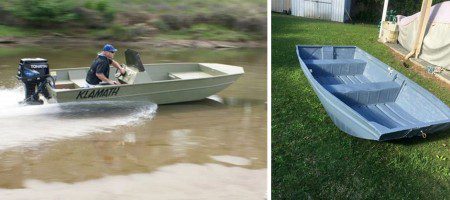
Modified V
Boats with a modified V hull are also well suited for rivers, lakes and near shore, but they tend to be a “wet boat” when the waves pick up. That means the boat tends to break through the waves such that the water splashes into the boat. When running in light choppy waves they handle well, are fairly dry for the passengers, and can navigate fairly shallow water, depending on the passenger and equipment load. Both center console fishing boats and open bow runabouts tend to have modified V hulls.
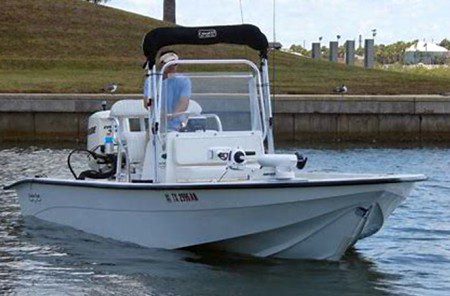
Modified V hulls start out at the bow with a small V and transition to a flat bottom about halfway to the stern. They will “split” the waves as long as the waves are not too high. Because of the V shape modified V hull boats track through the water better than flat bottom boats, which tend to slide when you make a sharp turn. The majority of fishing boats designed for rivers, lakes, and near shore fishing are modified V hull boats. Open bow runabouts, which are perfect for families cruising the rivers and lakes, also usually have a modified V hull.
Deep V Hull
Boats with a deep V hull are made for handling larger waves such as you would find in lakes, near shore and offshore. In waves large enough to get passengers wet in a boat with a modified V hull, the deep V hulled boat pushes the water far enough way that the passengers generally experience a much drier ride. Specialty boats such as wake riders, which are designed to produce a large wake for wake boarding, usually have a deep V hull. Many bow riders, so called because most of the passengers sit forward in seating on the bow, also have deep V hulls so the passengers don’t get wet from the bow spray.
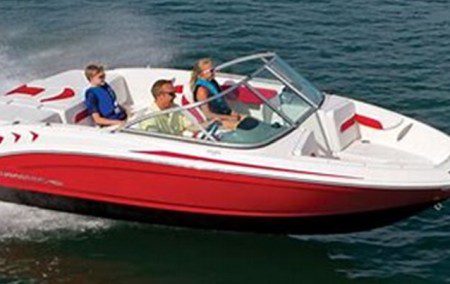
Deep V hull boats also tend to have a higher gunwale (side). They also tend to be longer than the average boat with a modified V. One of the most important considerations when getting a longer/larger boat is whether the boat is trailerable or not. If it is too big to be trailered, you will need to keep it in a wet slip or a dry stack. Think $$$.
Pontoon Boats
Pontoon boats are very versatile. Although they are most at home on a lake where the water is calm, When I moved to the beach from Belton Lake I brought my pontoon boat with me. They are well suited to family activities such as cruising, skiing, tubing, fishing, and just anchoring and using them as a swim platform. There are two basic types. The more common type in the two pontoon boat. They typically have a 40-50 hp engine and have a top speed of maybe 20 mph. They will cruise all day on $10 worth of gas. They are much cheaper than the three pontoons type.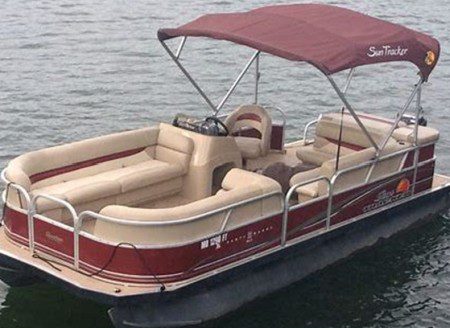
When I was looking at boats I wanted to get a modified V boat with enough horse power to run 40-50 mph. But my wife said no, we have many young grandkids, and we need a pontoon boat so we can carry them all. She said we could get a big tube to pull behind the boat and that should be all we need. Huh. So I get the grand kids out there on the pontoon, put the tube in the water, and crank it up to 19 mph (best I could ever get out of it). I slinged the grandkids around, went in circles, and they were having a good time, but I soon heard the inevitable: “Faster, Grandpa, faster!”
Pontoon boats almost always come with a top that can be opened to keep everyone from frying. Another thing about pontoon boats is that they can generally carry more passengers per length than a traditionally hulled boat. My pontoon boat was only 18 feet long, but it was rated for 11 passengers. My 18 foot center console fishing boat is rated for 3. I actually like the limitation on the fishing boat. As much as my pontoon boat was set up for cruising, it was also a fishing boat. It had a large live well and two captain’s chairs forward. We liked to anchor out in the middle of the lake and use the boat as a swimming platform. Those who didn’t want to swim could lay out on one of the large, padded seats and work on their tan, or get under the canopy and just listen to the music and chill. There was a table that was stored behind the rear seat that you could set up and have a nice meal or play cards if the wind wasn’t blowing too hard. The pontoons sliced though all but the heaviest waves that you might find on a lake, and handled one foot waves out in the bays.
The only downside to a pontoon boat, other than the top speed on the two pontoon models, was that they could be hard to maneuver at the dock or ramp whenever there was any wind. You might have it perfectly lined up for the trailer and a gust of wind would blow you off course. In cases like that I would attach the winch line to the boat, have my wife turn the winch handle, and I would get in the water and guide the boat onto the trailer.
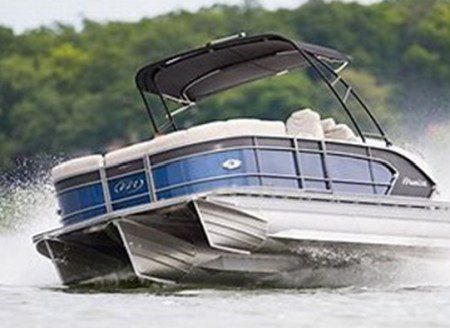
The three pontoon boats are a different animal. You can put a much larger horsepower engine on them, and cruising at 40-50 mph is quite doable. Bring more money!
Tunnel Hull Boats
Tunnel hull boats almost look like pontoon boats (at least to me) in that there is air under the majority of the hull space, otherwise know as the tunnel. Tunnel hulls are exceptionally fast as compared to conventional hulls, and they can navigate much shallower water than a conventional hull. They tend to be either a speed boat or a fishing boat, but rarely both. Tunnel hull fishing boats are excellent bay boats. Only an airboat or a mud boat can run shallower. Mud boats require a little water (as little as an inch or two) while air boat don’t require any water at all (but it is easier on the hull if there is a little water). Specialty boats such as tunnel hulls do cost more, but if you like the excitement from running 70-80 mph on the water, then they are the boat for you.

Hey Buddy, Got Anything Bigger?
Yes, we sure do! If you have the bucks, we have Cuddy Cabins, Cabin Cruisers, Catamarans, and Trawlers. The average recreational motorboat is in the 18-25 foot range. Boats measuring less than 16 feet in length are Class A boats. Boats measuring between 16 feet but less than 26 feet are classified as Class 1 boats. The majority of boats found on rivers and lakes are Class 1 boats. Boats from 26 feet to 40 feet are Class 2 boats. Boats measuring more than 40 feet but less than 65 feet are Class 3. Anything longer than 65 feet is a ship! Below is the 87-foot U.S. Coast Guard Cutter TIGER SHARK.
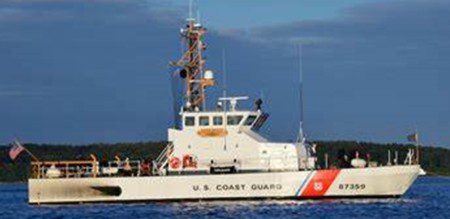
Cuddy Cabin
Well, it’s got a small cabin, and you can definitely sleep in it overnight, but you wouldn’t want to go on a long trip as you only have the very basic basics. Cuddy cabin boats are typically in the 22-30 foot range. They often have twin outboard engines instead of an inboard, although may cuddy cabins do have a single inboard engine, and often that inboard engine is a gasoline engine. Some have large fuel tanks and have up to a 100 mile range (100 miles out and 100 miles back). But you aren’t taking off for the Bahamas in one. Note that this cuddy cabin is quite trailerable, another advantage of this class of boat.
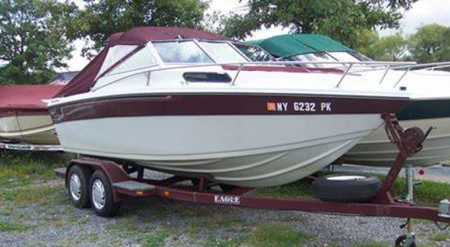
Cabin Cruisers
Most cabin cruisers are Class 3 boats; that is, in the 40-65 feet length. They usually have twin inboard diesel engines, a large fuel capacity, and more than one sleeping cabin. Some are like hotels on the water. The larger cabin cruisers fall into the yacht category (see below). You can live on a cabin cruiser, and many people do.
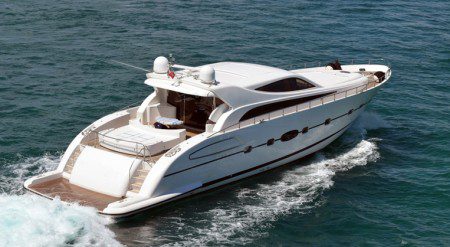
Catamarans
When most people hear the word catamaran the first thing that comes to mind is a sailboat, but there are many motorboats that are catamarans. They are called power catamarans, and range in size from 36-75 feet (and larger). The smaller catamarans are mostly cuddy cabins, whereas the larger ones are full cabin cruisers capable of making that trip from Galveston to the Bahamas. They are fast, very smooth in heavy seas, and quite economical when compared to traditional non-planing or semi-planing hull yachts.
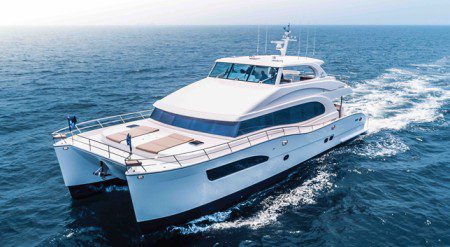
Trawlers
Trawlers are a type of motor yacht or powerboat with a design similar to small commercial fishing boats and can sometimes look like tugboats. Full displacement trawlers are designed for long distance cruising at an average speed of 8-10 knots. “Full displacement” means the hull is non-planing and the boat sits in the water to the same depth whether standing still or moving. There are also semi-displacement trawlers that will partially reach plane. The semi-displacement trawlers have reasonable storage and fuel capacity, comfortable accommodations, and can run at higher speeds up to 18-20 knots. All the boats discussed prior to the trawlers are all planing hull boats.
Yacht Class Boats
A yacht class boat is a vessel that is at least 10 meters (32.80 feet) in length, is capable of sailing in open sea or at a fairly long distance from the coast. It must also be able to withstand strong winds and large waves. Most Yacht Class boats are also Class 2 boats (40-65 feet). If you want to leave Galveston and head to the Bahamas, you want a Yacht Class boat preferably 40+ feet in length with twin diesel inboard engines and hundreds of gallons of fuel capacity. If you want a smooth ride in 10-foot seas then you will spring for the optional centrifugal stabilizer ($20,000 if you please).
Summary
There are many things to consider before buying a boat that is just right for you. For most people the first consideration is price, followed by the type of activity (cruising skiing, fishing, etc.). Whatever type of boat you choose, be sure to outfit it with all the required safety equipment such as life jackets, horns, navigation lights, and visual distress signals. Be sure to ask for a free Coast Guard Auxiliary Vessel Safety Check before getting out on the water, and if you were born after August 31, 1993, then you are required to take a Safe Boater Course.
[BC: Apr-16-2024]

 Posted in
Posted in 























